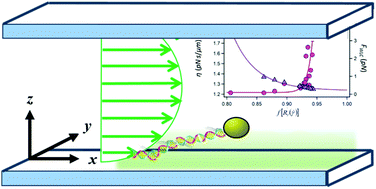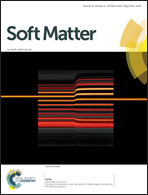The role of near-wall drag effects in the dynamics of tethered DNA under shear flow†
Abstract
We utilized single-molecule tethered particle motion (TPM) tracking, optimized for studying the behavior of short (0.922 μm) dsDNA molecules under shear flow conditions, in the proximity of a wall (surface). These experiments track the individual trajectories through a gold nanobead (40 nm in radius), attached to the loose end of the DNA molecules. Under such circumstances, local interactions with the wall become more pronounced, manifested through hydrodynamic interactions. To elucidate the mechanical mechanism that affects the statistics of the molecular trajectories of the tethered molecules, we estimate the resting diffusion coefficient of our system. Using this value and our measured data, we calculate the orthogonal distance of the extended DNA molecules from the surface. This calculation considers the hydrodynamic drag effect that emerges from the proximity of the molecule to the surface, using the Faxén correction factors. Our finding enables the construction of a scenario according to which the tension along the chain builds up with the applied shear force, driving the loose end of the DNA molecule away from the wall. With the extension from the wall, the characteristic times of the system decrease by three orders of magnitude, while the drag coefficients decay to a plateau value that indicates that the molecule still experiences hydrodynamic effects due to its proximity to the wall.



 Please wait while we load your content...
Please wait while we load your content...